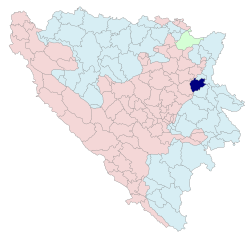Šekovići
| Šekovići Шековићи | ||
|---|---|---|
| Town and municipality | ||
| ||
 Location of Šekovići within Bosnia and Herzegovina | ||
| Coordinates: 44°18′N 18°51′E / 44.300°N 18.850°ECoordinates: 44°18′N 18°51′E / 44.300°N 18.850°E | ||
| Country | Bosnia and Herzegovina | |
| Entity | Republika Srpska | |
| Government | ||
| • Mayor | Momir Ristić (SNSD) | |
| Area | ||
| • Total | 237.2 km2 (91.6 sq mi) | |
| Population (2013 census) | ||
| • Total | 6,761 | |
| • Density | 29/km2 (74/sq mi) | |
| Time zone | UTC+1 (CET) | |
| • Summer (DST) | UTC+2 (CEST) | |
| Area code(s) | 56 | |
| Website |
www | |
Šekovići (Serbian Cyrillic: Шековићи) is a town and municipality located in northeastern Republika Srpska, an entity of Bosnia and Herzegovina. As of 2013, it has a population of 6,761 inhabitants.
History
From the Roman period to the present day major roads were cutting through the Šekovići region. These roads connected regions East of Drina River with Central Bosnia. Šekovići got its name by one portion of its inhabitants from Šekovina in Herzegovina, who immigrated to this region at the end of the 17th century. Until the end of the 17th century Sekovici was a well-inhabited area, till army invasions and different diseases decreased the population of Šekovići and almost wiped out the first people living there. Soon after that the new inhabitants from Herzegovina settled in Šekovići and they make up most of today’s populations. One of the first settlers beginning XVII left Šekovići, Ilija Birčanin, Hadži Milentije and Prote Matije Nenadović. Because of the family and other ties through the monastery this region had strong military cooperation with Serbia during the First Serbian Uprising. Ivan Groznog's mother Jelica Jakšić Glinska is from Šekovići and because of the Monastery Papraća and Russian Czar Palace had a good relationship. Monastery Lovnica and Papraca in the past were significant cultural and freedom centers. From the 16th century these two monasteries had ties with Russia, and monasteries in Serbia, Poland and Vlachs. Šekovići have special places in NOB (Serbian: Narodno Oslobodilacka Borba, English:Peoples Freedom Fight), they belong to one of the first uprising regions in Yugoslavia. In Šekovići were formed the Prva Bircanslka Brigada (First Birac Brigate), Sesta Istocnobosanska Brigada (Sixst Estern Bosnian Brigate) and Prva Pionirska Divizija ( First Pionir Division). In 1943, Sekovici was the military, political and cultural center for eastern Bosnia, according to author Rudi Petovara. Inside of it was the highest military and political leadership for Eastern Bosnia.
Demographics
| Historical population | ||
|---|---|---|
| Year | Pop. | ±% p.a. |
| 1971 | 10,570 | — |
| 1991 | 9,639 | −0.46% |
| 2013 | 6,761 | −1.60% |
Ethnic groups
- 1971
10,570 total
- Serbs - 10,241 (96.88%)
- Bosniaks - 286 (2.70%)
- Croats - 6 (0.05%)
- Yugoslavs - 2 (0.01%)
- others - 35 (0.36%)
- 1991
According to the 1991 census the municipality had a population of 9,639, including:
- Serbs (94.26%)
- Bosniaks (3.40%)
- others (2.34%)
The town itself had a population of 4,323 with 97% Serbs and 3% others. Most of the Bosniak population lived in the village of Papraća.
- 2013
| Municipality | Nationality | Total | |||||
|---|---|---|---|---|---|---|---|
Bosniaks |
% |
Croats |
% |
Serbs |
% | ||
| Šekovići | 107 | 1.58 | 8 | 0.11 | 6,618 | 97.88 | 6,761 |
Page text.[1]
See also
References
External links
| Wikimedia Commons has media related to Šekovići. |
.svg.png)